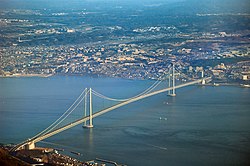| Akashi Kaikyō Bridge Akashi Kaikyō Ō-hashi (明石海峡大橋) | |
|---|---|
 Akashi Kaikyō Bridge from the air. | |
| Other name(s) | Pearl bridge |
| Carries | 6 lanes of roadway |
| Crosses | Akashi Strait[1] |
| Locale | Awaji Island and Kobe[1] |
| Maintained by | Honshū-Shikoku Bridge Authority |
| Design | Suspension bridge[1] |
| Total length | 3,911 meters (12,831 ft) |
| Height | 282.8 metres (928 ft) (pylons)[1] |
| Longest span | 1,991 meters (6,532 ft)[1] |
| Clearance below | 65.72 metres |
| Construction begin | 1988[1] |
| Construction end | 1998[1] |
| Opened | April 5, 1998 |
| Toll | ¥2,300 |
| Coordinates | 34°36′59″N 135°01′13″ECoordinates: 34°36′59″N 135°01′13″E |
The bridge is one of the key links of the Honshū-Shikoku Bridge Project, which created three routes across the Inland Sea.
Contents
|
History
Before the Akashi Kaikyō Bridge was built, ferries carried passengers across the Akashi Strait in Japan. This dangerous waterway often experiences severe storms, and in 1955, two ferries sank in the strait during a storm, killing 168 people. The ensuing shock and public outrage convinced the Japanese government to develop plans for a suspension bridge to cross the strait. The original plan called for a mixed railway-road bridge, but when construction on the bridge began in April 1986, the construction was restricted to road only, with six lanes. Actual construction did not begin until May 1986, and the bridge was opened for traffic on April 5, 1998. The Akashi Strait is an international waterway that necessitated the provision of a 1,500-metre (4,921 ft)-wide shipping lane.Architecture
The bridge has three spans. The central span is 1,991 m (6,532 ft),[1] and the two other sections are each 960 m (3,150 ft). The bridge is 3,911 m (12,831 ft) long overall. The central span was originally only 1,990 m (6,529 ft), but the Kobe earthquake on January 17, 1995, moved the two towers sufficiently (only the towers had been erected at the time) so that it had to be increased by 1 m (3.3 ft).[1]The bridge was designed with a two-hinged stiffening girder system, allowing the structure to withstand winds of 286 kilometres per hour (178 mph), earthquakes measuring to 8.5 on the Richter scale, and harsh sea currents. The bridge also contains pendulums that are designed to operate at the resonance frequency of the bridge to damp forces. The two main supporting towers rise 298 m (978 ft) above sea level, and the bridge can expand because of heating up to 2 m (7 ft) over the course of a day. Each anchorage required 350,000 tonnes (340,000 LT; 390,000 ST) of concrete. The steel cables have 300,000 kilometres (190,000 mi) of wire: each cable is 112 centimetres (44 in) in diameter and contains 36,830 strands of wire.[2][3]
The Akashi-Kaikyo bridge has a total of 1737 illumination lights: 1084 for the main cables, 116 for the main towers, 405 for the girders and 132 for the anchorages. On the main cables three high light discharged tubes are mounted in the colors red, green and blue. The RGB model and computer technology make for a variety of combinations. Currently, 28 patterns are used for occasions as national or regional holidays, memorial days or festivities.[citation needed]



No comments:
Post a Comment